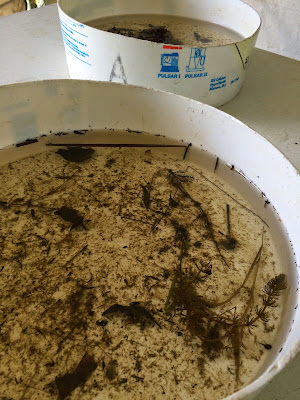GLEP!
Great Lakes Education
Program
Our day was chock full of
wonderful experiences. From the moment
we boarded our super cool bus, kids were hooked. Our adventure began on land, where kids
learned about marshlands and investigated Lake Erie marshland critters. What did they find!? predaceous diving beetle larvae
scud
water flea
water boatman
dragonfly nymph
mayfly larvae
damselfly nymph
They learned how to place a
specimen on a slide and using the microscope, figured out what they were
looking at.
Kids learned about marshlands and
the plants and animals that live within the marsh. Mink, muskrats, snakes, turtles, cattails,
grasses, and much more.
Because they occur
where the dry land meets the water, wetlands play a critical role in the
management of our water based resources.
Acre for acre,
wetlands produce more wildlife and plants than any other Michigan habitat type.
Wetland species also comprise a critically important segment of these species.
For example, Michigan boasts about 2300 native plant species; 50 percent of
these are wetland species and over 25 percent of the wetland species are
threatened or endangered. More than 40 percent of the 575 vertebrate (with a
backbone) wildlife species in Michigan live in or utilize wetlands. This
includes 10 to 15 of the 66 mammals, 180 of the 370 birds, 22 of the 28
reptiles, and all of the 23 amphibians.
Here are a few
other things that wetlands do:
- reduce flooding by absorbing runoff from rain
and melting snow and slowly releasing excess water into rivers and lakes -
a one acre swamp when flooded to a depth of one foot contains 330,000
gallons of water
- filter pollutants from surface runoff,
trapping fertilizers, pesticides, sediments, and other contaminants and
helping to break some of them down into less harmful substances, improving
water clarity and quality
- help recharge groundwater supplies when
connected to underground aquifers
- contribute to natural nutrient and water
cycles, and produce vital atmospheric gases, including oxygen
- provide commercial or recreational value to
our human economy, by producing plants, game birds (ducks, geese) and fur
bearing mammals - many fish are directly connected to wetlands, requiring
shallow water areas for breeding, feeding and escaping from predators
- when wetlands occur adjacent to the Great
Lakes, inland lakes or streams, they serve as nutrient traps that then
enrich the larger body of water of which they are part
The extent of
wetland habitat was once controlled by natural processes. Marshes along the
Great Lakes and drowned river mouth lakes vary in size, depending on rainfall
trends and Great Lakes water levels. The natural filling of old glacial lakes
with plant remains and sediment will create bog habitat. Eventually through
continued succession, open water may be eliminated, replaced with a continuous
sphagnum bog or a wet meadow. Floodplain swamps may shrink or increase with the
normal changes in a river's channel over time. Over the long term, such natural
change is inevitable. Wetland areas in Michigan have been growing, shrinking
and re forming according to natural cycles since the last Ice Age and before,
and these cycles continue today.
The last century
has seen a greatly increased rate of wetland loss due to filling and drainage
by man. Prior to World War 11, drainage to expand agricultural lands accounted
for most of this loss. Recently, much wetland destruction has been caused by
commercial, industrial, and residential expansion. The estimated 11 million
acres of Michigan wetlands existing in pre settlement times has now been
reduced to less than 3 million acres. Recent legislation has slowed the loss
rate somewhat but threats to these habitats, particularly the smaller wetlands,
continue in many areas.
Information from
Michigan Department of Natural Resources
(http://www.michigan.gov/dnr)
Our boat! What an adventure. There are four stations on the boat and after
the kids have been outfitted with a life jacket, they go to their first
station.
Station 1 (bow):
Marlinspike (marine knot tying)
Sailors use knots to make their
jobs easier and safer. Kids practiced a
variety of knots while on the boat.
Station 2 (Front
table): “Beat the Teacher” Game – Marine Debris
Marine debris, is human-created
waste. Yuck. Protect our lakes! How long does it take to degrade or
decompose?
Paper Towel: 2-4 weeks
Cotton Rope: 1-5 months
Apple Core: 2 months
Plywood: 1-3 years
Plastic Grocery Bags: 1-20 years
Foamed Plastic Cup: 50 years
Tin Can: 50 years
Aluminum Can: 200 years
Station 3 (rear
table): Navigation (maps!)
What way does water flow through
the Great Lakes?
Water flows downhill from Lake
Superior into Michigan/Huron, then Erie, next through Ontario and eventually
into the Atlantic Ocean. How long does
this process take!? (200 years!)
What are the blue markings
between open water and dry land, mostly on the Canadian side of the lake?
Wetlands
Why aren’t there many wetlands on
the U.S. side?
Coastal development
What do the black numbers on the
water represent?
Water depth
What do the purple and green
teardrop shaped objects represent?
Navigation buoys
Station 4
(stern): Plankton
Plankton is AWESOME! Plankton forms the base of the aquatic food
web. Zooplankton is animal plankton. Zooplankton can swim on its own, but is
largely carried from place to place by currents.
Phytoplankton is plant
plankton. Phytoplankton is green because
of the chlorophyll it contains, and like other green plants, it makes
oxygen. Most of the oxygen we breathe
comes from phytoplankton in the oceans!
Exploring the BOTTOM Habitat
The bottom dredge takes a bite
out of the bottom, and brings it up to the boat in order for kids to examine
it.
The underwater camera allows kids
to see what is beneath the schoolship.
What did you see!?
Water Clarity
We measure water clarity using a
Secchi Disk. Putting the disk into the
water you can see through the water to measure the clarity, depending on how
deep you can lower the disk before you are unable to see it.
pH

















































No comments:
Post a Comment